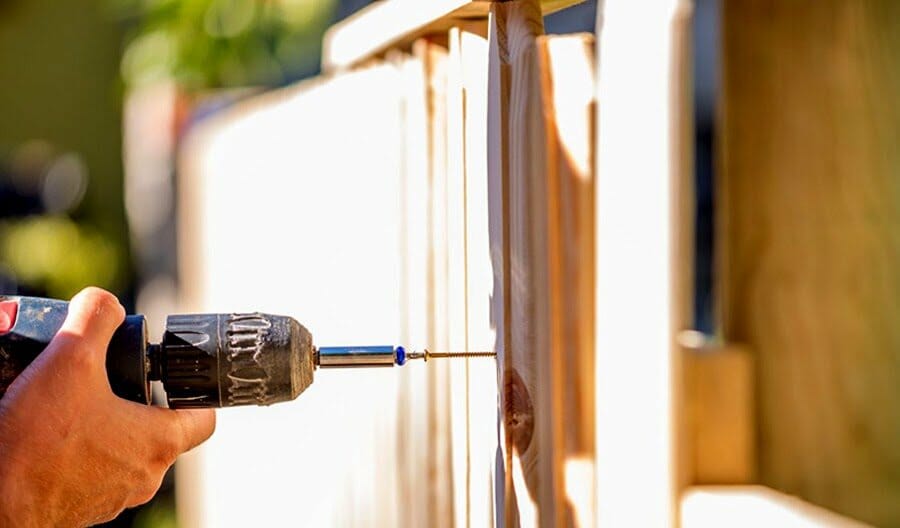Neighbors often manage infrequent conflicts and disputes effectively. Yet, when the contention centers on the ownership or placement of a dividing fence, it can escalate into hostility and prove challenging to settle.
To help Massachusetts residents address such issues, the state passed a property line and fence law that landowners can follow.

What we cover
ToggleDo I need a permit to build a fence in Massachusetts?
No. According to the Massachusetts State Building Code on fencing, you won’t need a permit to put up a fence under 7 feet. Most towns that don’t have local fencing regulations defer to this rule.
However, in cities such as Milford, Leicester, and Gloucester, building permits are only required for fences over 6 feet. Nevertheless, zoning permits may be required for commercial or industrial properties.
Contact your local planning department if you’re unsure of their permit regulations.
Can I replace an existing fence without a permit?
Mostly no. Fence replacements in most parts of Massachusetts require a permit, even if you’re making an identical replacement. As stated in Chapter 2 of the State’s Building code, conducting ordinary repairs is the only act exempted from obtaining a permit.
But for fences in a town with its own fence regulations like Woburn, you are allowed to replace an existing fence without a permit provided you install it back to its original legal location and complete the job within 30 days.
How tall can a privacy fence be in Massachusetts?
Privacy fences in residential districts aren’t expected to exceed 7 feet. The front yard fences have a maximum height limit of four feet, and the backyard and side fences, 7 feet. (Some towns have a maximum height limit of 6 feet).
Corner lot fences are limited to a 3 feet height to avoid obstructing visual clearance of the intersecting streets.
Property owners who want to extend their fence heights can apply for a variance at the local building department.
Who owns the fence on property lines in MA?
The owners of the adjoining properties enclosed by that partition fence are by law recognized as the owners. Under Mass. 49 § 3, each of the property owners must share equally in maintaining the fence unless they agree otherwise.
How do you know where the property boundary is?
To locate your property boundaries, you’ll need to hire a surveyor. Survey data is very accurate since the surveyors will assess historical images, land records at the registry of deeds, and available plat maps to locate the true boundary.
You can also check the property details on your deed and other ownership documents. These could indicate any covenants or contracts set up by the past owners that affect the boundary position.
Depending on your county or town, you can also try to access your street’s plat map to establish the boundaries. These maps are usually available at your Assessor’s office or their website.
Can my neighbor build a fence on the property line?
Yes. In most township fence regulations in Massachusetts, property owners are allowed to build fences right to the property line. As long as it’s not a partition fence, he/she won’t have to seek your permission.
Nonetheless, if you both keep livestock or pets on your property, the law under Mass. 49 § 10 allows the neighbor to demand you to build a sufficient fence on your part of the determined division line.
If you refuse to build or repair that fence, the neighbor can invite fence viewers to hear and determine the case. If you also neglect the fence viewer’s ruling, the other neighbor can cover the costs of that fence, then demand double the deficient amount for compensation.
Can I put up a fence on my side of the property line?
Yes! If you need to keep your animals inside or to protect your backyard garden, the law allows you to construct a fence just inside your side of the property line.
However, you’ll be expected to shoulder responsibilities for determining the position of your property boundaries. This could be through conducting a survey or consulting your neighbor to ensure you don’t encroach on their land.
There are also several fence height and zoning ordinances that you’ll have to observe from your Homeowners Association.

What is a spite fence?
A spite fence refers to any fence built out of ill motives and intentions to annoy and interrupt the adjoining owner’s enjoyment of their property.
Such a fence includes any overly tall structure, including hedges, shrubs, or a row of trees. They are deemed illegal in most states in the country.
Spite Fences and Your Right to Sunlight
The Massachusetts fence laws in Mass. 49 § 21 define spite fences as any fencing structure taller than 6 feet maliciously constructed to annoy a neighbor. Under this section, it’s considered a private nuisance, and anyone injured from the structure may seek legal action for tort damages.
Note: Property owners in Massachusetts don’t have a right to sunlight. This means that if your neighbor’s fence casts a shadow on your property, you can’t take any action against it – unless you can prove malicious intent for its construction in court.
Massachusetts Fence and Property Line Laws Basics
Fence and property line laws in Massachusetts are quite comprehensive for property owners. Besides the general State Building code on fencing, most counties and subdivisions have crafted specific local laws governing property lines.
Under these laws, adjoining neighbors are required to share responsibilities for the fences on their boundaries. Disputes are all required to be resolved through fence viewers or the courts for severe cases.
Adjoining property owners also have the freedom to come with unique agreements in writing, that become legally binding. Additionally, separate ordinances from town councils and HOAs, still apply for all fences.
What is a Fence Viewer's Role in Resolving Disputes?
Fence viewers in Massachusetts are tasked with the responsibility of arbitrating fence disputes among property owners. Every town in the state appoints at least two fence viewers each year to handle the job.
Under Mass. 49 § 18, the fence viewers have the power to determine whether a partition fence is sufficient and if it’s required.
They also determine how much every neighbor should contribute towards repairs, construction, or maintenance of a fence.
When Are You Required to Share Fence Costs?
Adjoining property owners are generally required to share the costs of fence maintenance, building, or repairs in equal proportions unless they agree otherwise.
Failure to make your contributions violates Mass. 49 § 4 and allows the other neighbor to invite county fence viewers. They can then demand twice the amount you should have paid for the repairs, plus interest if you don’t pay within 30 days.
Massachusetts’ boundary fence laws at a glance
This table provides an overview of some of the state laws governing Massachusetts’ fence laws and links to their original documents.
| Statues | Remedies for Encroachment | Local Fence Regulations |
|---|---|---|
| Mass. 49 § 3 Boundary fence regulations Mass. 49 § 4 Failing to maintain fence Mass. 241 § 1 Private nuisance | When a neighbor places a structure that intrudes on your land, you can: Provide a written agreement for the use; Request the removal of the encroaching structure; Get a survey of your property; File a complaint with your city’s zoning or permit department; File an action in court. | City of Boston Fence regulations The city of Springfield Zoning and ordinance The city of Worcester Zoning and ordinance |
Keep in mind; These laws are bound to change with time depending on the new legislation, federal court decisions, and other initiatives. Use the information provided above as a guide and research the latest regulations in your municipality.
FAQ's
Who owns the fence between neighbors?
Unless the neighbors have agreed otherwise, the Massachusetts fence laws acknowledge both neighbors as the fence owners. As such, each neighbor is liable to maintain an equal share of the fence maintenance and repair costs.
What if a new fence is blocking my view?
All fences greater than 6 feet built to interfere with the enjoyment of your property are deemed a private nuisance. So, if you can prove this fence was erected out of evil motives, the court can have the fence removed and grant you tort damages money.
Can my neighbor hang things on my fence?
If you’ve allowed them to, then yes. However, if the neighbor hangs or leans something against your fence without your consent and causes any damages, they’ll have to bear the costs of repair.
Can I paint my side of the fence?
The short answer is no. Legally, you’re not allowed to alter your neighbor’s fence for any reason. If you have an issue with the fence’s paint color, you have to ask for permission from the neighbor to paint your side.
Can I build a fence next to my neighbor’s fence?
Yes! There’s no law prohibiting you from putting up a fence next to your neighbor’s fence. If you don’t want to keep asking for permission to paint or make any changes to the fence structure, building your fence is the way to go!
What is a property line encroachment?
Property line encroachment refers to the intentional or unintentional action of an adjoining property owner to put up a structure (e.g., shed or fence) that extends well into your side of the property line.












